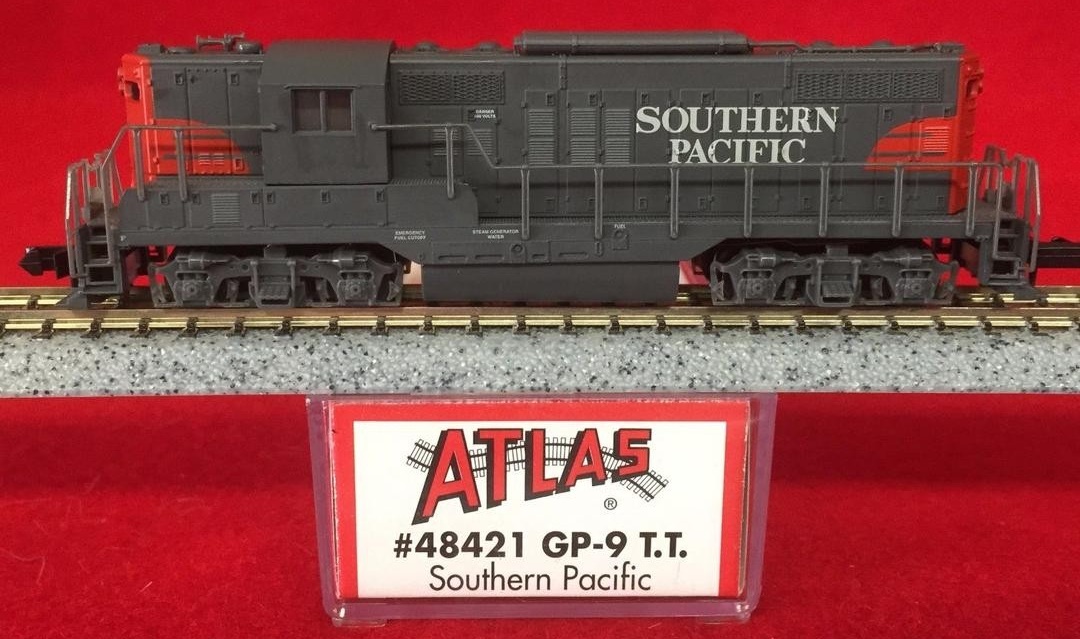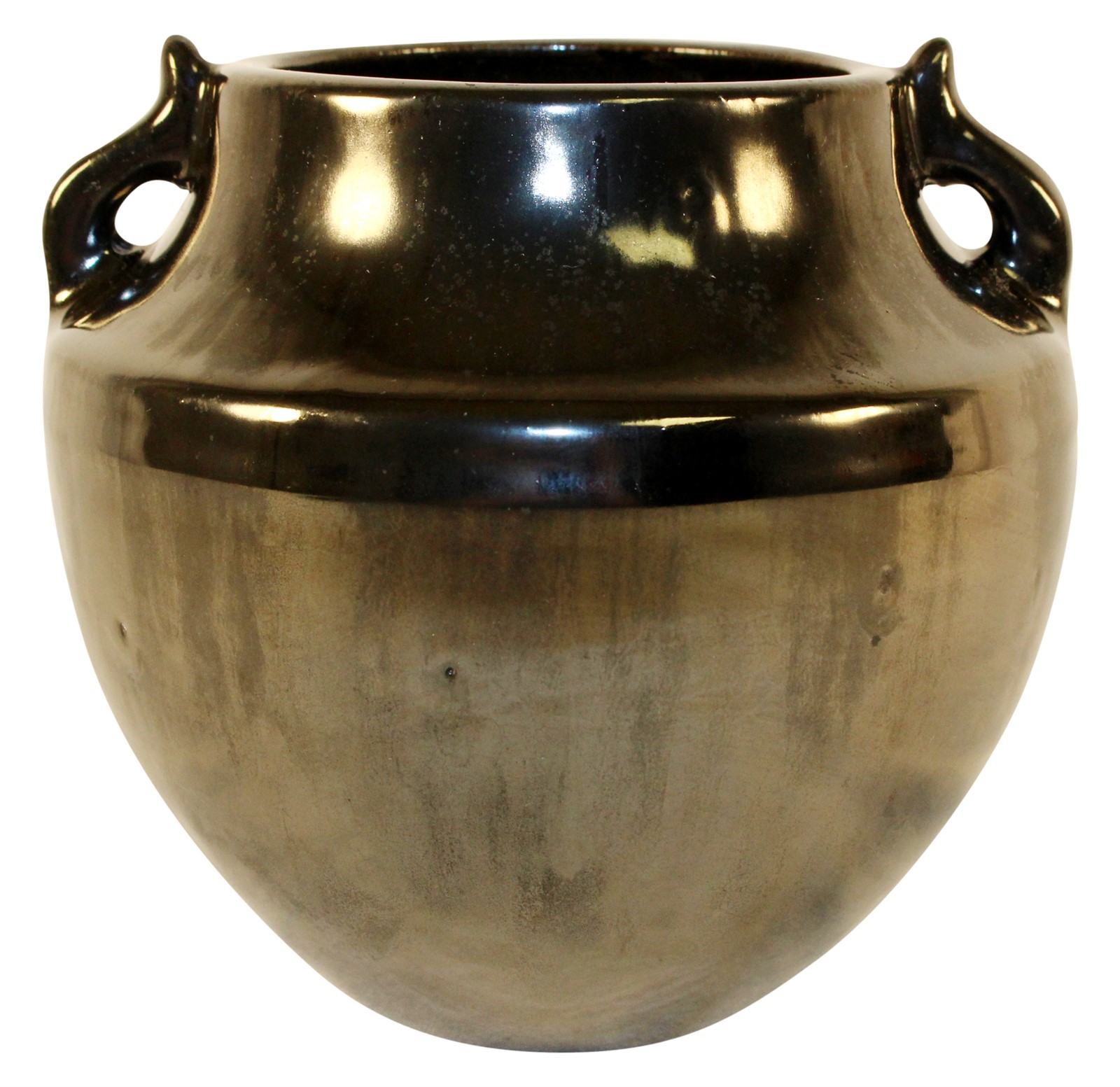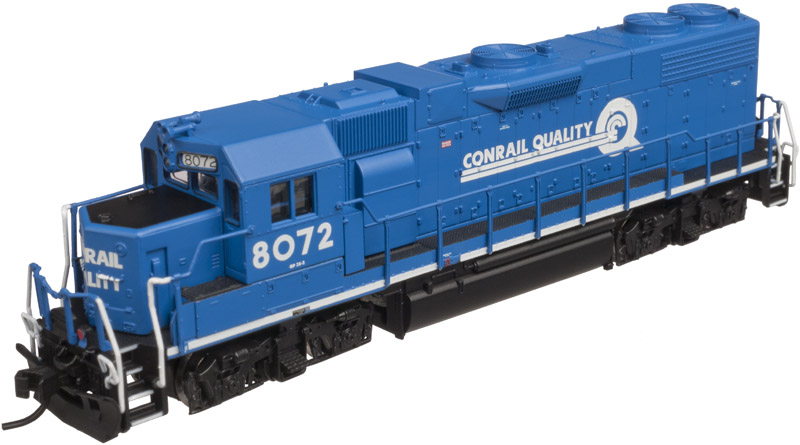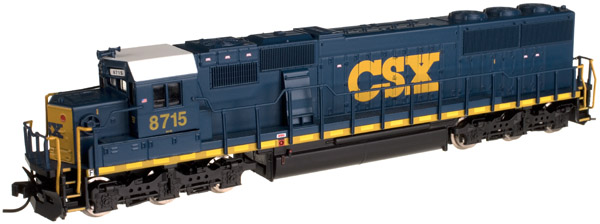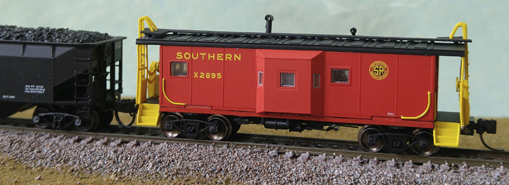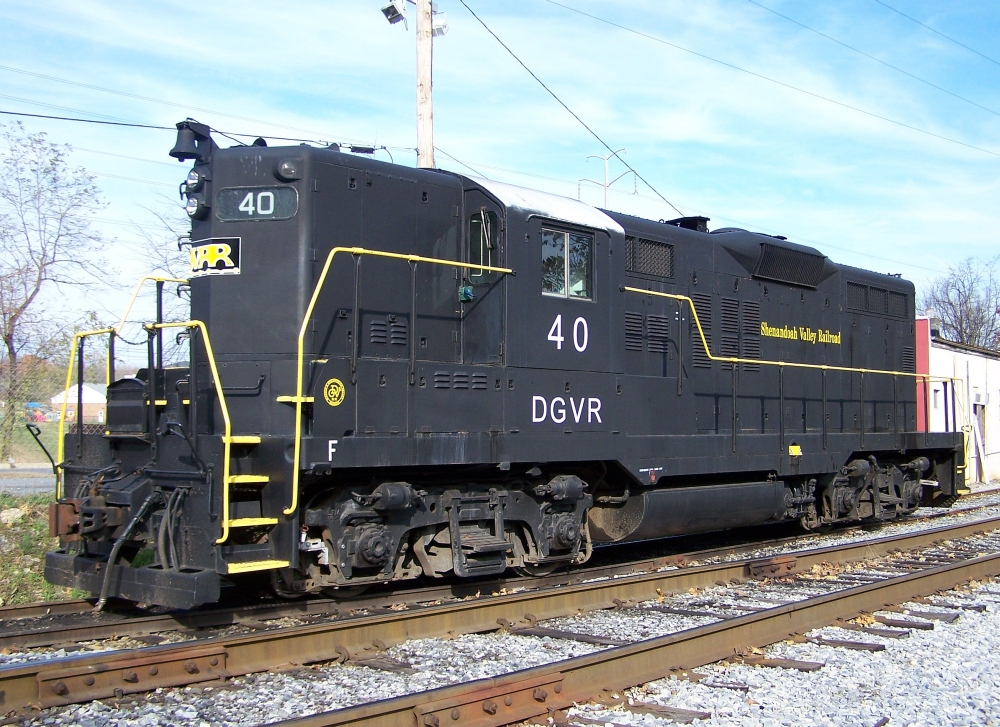Model Information: The Atlas GP7, GP7-TT, GP9 and GP9-TT models are some of Atlas' oldest models. The four locomotives share the same internal mechanisms and differ only in their shell details. Unlike many of their other older body styles, these bodies have been updated several times and are still a regular part of the Atlas production cycle.
Given their long history of releases, these models come in a plethora of different versions. The first release of this body type was in 1974 and the models were produced by Roco in Austria. Production for these models ended in 1982. The next release started in 1987 and the models were re-tooled by Kato in Japan for Atlas. The Kato version re-used the same mechanism as was used in the earlier RS3. It doesn't work as well in the Geep. The third version was made in China for Atlas and these engines were essentially a redo of the Kato mechanism (with all the faults). Finally, in 2006, the mechanism was redone properly and this 4th version is a properly DCC-Ready split frame, slow-motor modern engine.
Assembly instructions from Atlas: GP9 (Japan version), GP9 Ph.2 (China version), GP9 Torpedo Tube.
Given their long history of releases, these models come in a plethora of different versions. The first release of this body type was in 1974 and the models were produced by Roco in Austria. Production for these models ended in 1982. The next release started in 1987 and the models were re-tooled by Kato in Japan for Atlas. The Kato version re-used the same mechanism as was used in the earlier RS3. It doesn't work as well in the Geep. The third version was made in China for Atlas and these engines were essentially a redo of the Kato mechanism (with all the faults). Finally, in 2006, the mechanism was redone properly and this 4th version is a properly DCC-Ready split frame, slow-motor modern engine.
Assembly instructions from Atlas: GP9 (Japan version), GP9 Ph.2 (China version), GP9 Torpedo Tube.
DCC Information: The first version of this engine (Roco) gets a solid "No" for DCC capability, but this is no surprise as these were made in 1974. The next two releases (Kato and China) are split-frame, but also split-board. They may be DCC-Friendly, but likely it will be a fair amount of work to upgrade these. The most recent version (China, 2006+) is eminently DCC-Ready. Furthermore, most road-names and numbers produced since 2006 are available in both a DCC-Ready and a Decoder-Equipped version. Earlier DCC factory-equipped versions were fitted with Lenz LE063XF decoders, whereas most recent versions are fitted with NCE N12A2 decoders. The Atlas version of these decoders will respond to manufacturer's address "127" (CV8) i.e. "Atlas Model Railroad Products", though being identical to their original manufacturer's specification.
For non-DCC-ready versions, a wired DCC decoder installation for this model can be found on Brad Myers' N-scale DCC decoder installs blog.
Models produced since 2006 accept the following plug-in decoders:
- Digitrax DN163A4: 1.5 Amp N Scale Board Replacement Mobile Decoder for Atlas GP30 and other short Atlas diesel locomotives.
- Digitrax DN163A2: Retired decoder, replaced by DN163A4.
- NCE N12A2: Plug and play decoder for N-Scale Atlas Classic Series GP7, GP9, GP30, GP35.
- TCS ASD4 (Installation for GP7, Installation for GP9)
- MRC 1955: N-Scale Sound Decoder for Atlas GP-7, GP-9, GP-30 or GP-35
For non-DCC-ready versions, a wired DCC decoder installation for this model can be found on Brad Myers' N-scale DCC decoder installs blog.
Models produced since 2006 accept the following plug-in decoders:
- Digitrax DN163A4: 1.5 Amp N Scale Board Replacement Mobile Decoder for Atlas GP30 and other short Atlas diesel locomotives.
- Digitrax DN163A2: Retired decoder, replaced by DN163A4.
- NCE N12A2: Plug and play decoder for N-Scale Atlas Classic Series GP7, GP9, GP30, GP35.
- TCS ASD4 (Installation for GP7, Installation for GP9)
- MRC 1955: N-Scale Sound Decoder for Atlas GP-7, GP-9, GP-30 or GP-35
Prototype History: An EMD GP9 is a four-axle diesel-electric locomotive built by General Motors' Electro-Motive Division in the United States, and General Motors Diesel in Canada between January, 1954, and August, 1963. US production ended in December, 1959, while an additional thirteen units were built in Canada, including the last two in August, 1963. Power was provided by an EMD 567C sixteen-cylinder engine which generated 1,750 horsepower (1.30 MW). This locomotive type was offered both with and without control cabs; locomotives built without control cabs were called GP9B locomotives. All GP9B locomotives were built in the United States between February, 1954, and December, 1959.
One option available for locomotives without dynamic brakes, was to remove the two 22.5 in × 102 in (571.5 mm × 2,590.8 mm) air reservoir tanks from under the frame, and replace them with four 12 in × 150.25 in (304.80 mm × 3,816.35 mm) tanks that were installed on the roof of the locomotive, above the prime mover. These “torpedo tubes” as they were nicknamed, enabled the fuel and water tanks to be increased to 1,100 US gallons (4,200 l; 920 imp gal) each, although some railroads opted for roof-mounted air tanks and 2,200 US gallons (8,300 l; 1,800 imp gal) fuel tanks on their freight ‘Geeps’.
From Wikipedia
One option available for locomotives without dynamic brakes, was to remove the two 22.5 in × 102 in (571.5 mm × 2,590.8 mm) air reservoir tanks from under the frame, and replace them with four 12 in × 150.25 in (304.80 mm × 3,816.35 mm) tanks that were installed on the roof of the locomotive, above the prime mover. These “torpedo tubes” as they were nicknamed, enabled the fuel and water tanks to be increased to 1,100 US gallons (4,200 l; 920 imp gal) each, although some railroads opted for roof-mounted air tanks and 2,200 US gallons (8,300 l; 1,800 imp gal) fuel tanks on their freight ‘Geeps’.
From Wikipedia
Road Name History: 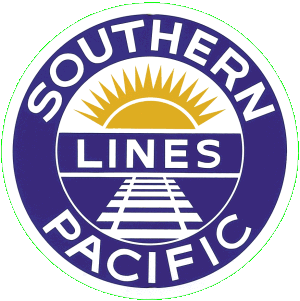 The Southern Pacific Transportation Company (reporting mark SP), earlier Southern Pacific Railroad and Southern Pacific Company, and usually called the Southern Pacific or (from the railroad's initials) Espee, was an American Class I railroad. It was absorbed in 1988 by the company that controlled the Denver and Rio Grande Western Railroad and eight years later became part of the Union Pacific Railroad.
The Southern Pacific Transportation Company (reporting mark SP), earlier Southern Pacific Railroad and Southern Pacific Company, and usually called the Southern Pacific or (from the railroad's initials) Espee, was an American Class I railroad. It was absorbed in 1988 by the company that controlled the Denver and Rio Grande Western Railroad and eight years later became part of the Union Pacific Railroad.
The railroad was founded as a land holding company in 1865, later acquiring the Central Pacific Railroad by lease. By 1900 the Southern Pacific Company was a major railroad system incorporating many smaller companies, such as the Texas and New Orleans Railroad and Morgan's Louisiana and Texas Railroad. It extended from New Orleans through Texas to El Paso, across New Mexico and through Tucson, to Los Angeles, through most of California, including San Francisco and Sacramento. Central Pacific lines extended east across Nevada to Ogden, Utah, and reached north through Oregon to Portland. Other subsidiaries eventually included the St. Louis Southwestern Railway (Cotton Belt), the Northwestern Pacific Railroad at 328 miles (528 km), the 1,331 miles (2,142 km) Southern Pacific Railroad of Mexico, and a variety of 3 ft (914 mm) narrow gauge routes.
In 1929 SP/T&NO operated 13848 route-miles not including Cotton Belt, whose purchase of the Golden State Route circa 1980 nearly doubled its size to 3,085 miles (4,965 km), bringing total SP/SSW mileage to around 13,508 miles (21,739 km).
By the 1980s route mileage had dropped to 10,423 miles (16,774 km), mainly due to the pruning of branch lines. In 1988 the Southern Pacific was taken over by D&RGW parent Rio Grande Industries. The combined railroad kept the Southern Pacific name due to its brand recognition in the railroad industry and with customers of both constituent railroads. Along with the addition of the SPCSL Corporation route from Chicago to St. Louis, the total length of the D&RGW/SP/SSW system was 15,959 miles (25,684 km).
By 1996 years of financial problems had dropped SP's mileage to 13,715 miles (22,072 km), and it was taken over by the Union Pacific Railroad.
Read more on Wikipedia.

The railroad was founded as a land holding company in 1865, later acquiring the Central Pacific Railroad by lease. By 1900 the Southern Pacific Company was a major railroad system incorporating many smaller companies, such as the Texas and New Orleans Railroad and Morgan's Louisiana and Texas Railroad. It extended from New Orleans through Texas to El Paso, across New Mexico and through Tucson, to Los Angeles, through most of California, including San Francisco and Sacramento. Central Pacific lines extended east across Nevada to Ogden, Utah, and reached north through Oregon to Portland. Other subsidiaries eventually included the St. Louis Southwestern Railway (Cotton Belt), the Northwestern Pacific Railroad at 328 miles (528 km), the 1,331 miles (2,142 km) Southern Pacific Railroad of Mexico, and a variety of 3 ft (914 mm) narrow gauge routes.
In 1929 SP/T&NO operated 13848 route-miles not including Cotton Belt, whose purchase of the Golden State Route circa 1980 nearly doubled its size to 3,085 miles (4,965 km), bringing total SP/SSW mileage to around 13,508 miles (21,739 km).
By the 1980s route mileage had dropped to 10,423 miles (16,774 km), mainly due to the pruning of branch lines. In 1988 the Southern Pacific was taken over by D&RGW parent Rio Grande Industries. The combined railroad kept the Southern Pacific name due to its brand recognition in the railroad industry and with customers of both constituent railroads. Along with the addition of the SPCSL Corporation route from Chicago to St. Louis, the total length of the D&RGW/SP/SSW system was 15,959 miles (25,684 km).
By 1996 years of financial problems had dropped SP's mileage to 13,715 miles (22,072 km), and it was taken over by the Union Pacific Railroad.
Read more on Wikipedia.
Brand/Importer Information: In 1924 Stephan Schaffan, Sr. founded the Atlas Tool Company in Newark, New Jersey. In 1933 his son, Stephan Schaffan, Jr., came to work for his father at the age of sixteen. Steve Jr. built model airplanes as a hobby and frequented a local hobby shop. Being an enterprising young man, he would often ask the owner if there was anything he could do to earn some extra spending money. Tired of listening to his requests, the hobby-store owner threw some model railroad track parts his way and said, "Here, see if you can improve on this".
In those days, railroad modelers had to assemble and build everything from scratch. Steve Jr. created a "switch kit" which sold so well, that the entire family worked on them in the basement at night, while doing business as usual in the machine shop during the day.
Subsequently, Steve Jr. engineered the stapling of rail to fiber track, along with inventing the first practical rail joiner and pre-assembled turnouts and flexible track. All of these products, and more, helped to popularize model railroading and assisted in the creation of a mass-market hobby. The budding entrepreneur quickly outgrew the limitations of a basement and small garage operation. Realizing they could actually make a living selling track and related products, Steve and his father had the first factory built in Hillside, New Jersey at 413 Florence Avenue in 1947. On September 30, 1949, the Atlas Tool Company was officially incorporated as a New Jersey company.
In 1985, Steve was honored posthumously for his inventions by the Model Railroad Industry Association and was inducted into the Model Railroad Industry Hall of Fame in Baltimore, Maryland. In addition, Steve was nominated and entered into the National Model Railroad Association Pioneers of Model Railroading in 1995.
In the early 1990s, the Atlas Tool Company changed its name to Atlas Model Railroad Company, Inc.
In those days, railroad modelers had to assemble and build everything from scratch. Steve Jr. created a "switch kit" which sold so well, that the entire family worked on them in the basement at night, while doing business as usual in the machine shop during the day.
Subsequently, Steve Jr. engineered the stapling of rail to fiber track, along with inventing the first practical rail joiner and pre-assembled turnouts and flexible track. All of these products, and more, helped to popularize model railroading and assisted in the creation of a mass-market hobby. The budding entrepreneur quickly outgrew the limitations of a basement and small garage operation. Realizing they could actually make a living selling track and related products, Steve and his father had the first factory built in Hillside, New Jersey at 413 Florence Avenue in 1947. On September 30, 1949, the Atlas Tool Company was officially incorporated as a New Jersey company.
In 1985, Steve was honored posthumously for his inventions by the Model Railroad Industry Association and was inducted into the Model Railroad Industry Hall of Fame in Baltimore, Maryland. In addition, Steve was nominated and entered into the National Model Railroad Association Pioneers of Model Railroading in 1995.
In the early 1990s, the Atlas Tool Company changed its name to Atlas Model Railroad Company, Inc.
Item created by: gdm on 2016-08-17 14:18:17. Last edited by Alain LM on 2019-07-30 02:31:30
If you see errors or missing data in this entry, please feel free to log in and edit it. Anyone with a Gmail account can log in instantly.
If you see errors or missing data in this entry, please feel free to log in and edit it. Anyone with a Gmail account can log in instantly.


